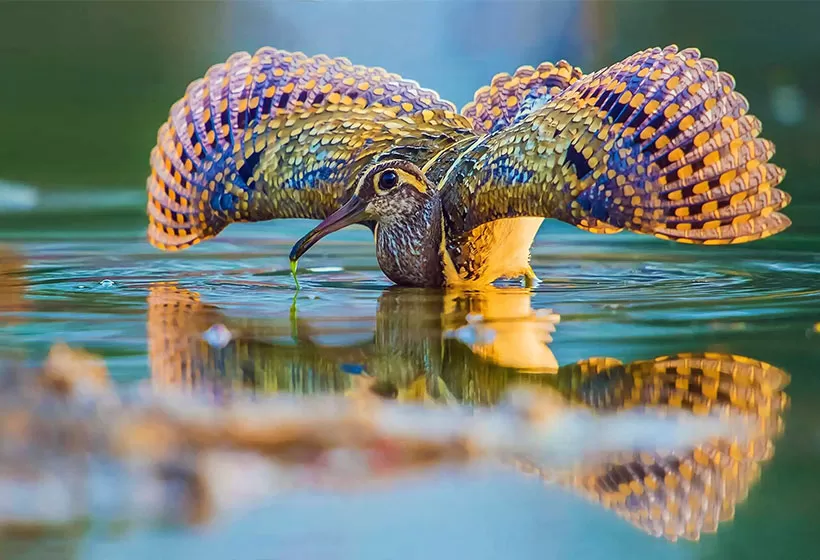Fujian Birding Itinerary and Birding Guide
Where to do a birding trip
Fujian province in China is known for its diverse bird population, making it an ideal destination for birding. Some popular birding spots in Fujian include:
Wuyi Mountain: This UNESCO World Heritage Site is home to over 400 bird species, including the Chinese blackbird, Chinese crested tern, and the Chinese bamboo partridge.
Jiuwu Mountain: This nature reserve is home to over 200 bird species, including the Chinese monal, Chinese hwamei, and the Chinese yuhina.
Minjiang Estuary: This wetland area is a popular spot for migratory birds and is home to a wide variety of bird species, including the black-faced spoonbill, the Chinese egret, and the Chinese marsh warbler.
Dongzhai National Nature Reserve: This is a major stopover site for migratory birds and is home to over 200 bird species, including the Chinese black stork, the Chinese grey shrike, and the Chinese egret.
You should consider hiring a local guide who can help you navigate these areas and point out the different bird species you can expect to see.
The best time for birding
The best time for birding in Fujian province, China, depends on the specific bird species you are interested in seeing. In general, the peak birding season in Fujian is from late April to early June, as many migratory bird species pass through the area during this time. This is also the time when many resident birds are breeding and are more active.
Additionally, the fall migration season (September to November) is also a good time to see migratory birds in Fujian.
You should also consider hiring a local guide who can help you navigate the areas and point out the different bird species you can expect to see at different times of the year. They can also provide more specific information about the best time to see certain species. Contact us and create your own birding trip »
Birding itineraries
3-day birding itinerary
Day 1: Start your day by visiting the Wuyi Mountains National Nature Reserve, which is known for its rich birdlife and is a UNESCO World Heritage Site. Look out for species such as the Chinese Hwamei, Black Bulbul, and Blue Whistling Thrush. In the afternoon, head to the Fuzhou Forest Park, where you can spot the White-throated Rock Thrush and the Black-faced Spoonbill. End the day by visiting the Fuzhou Strait Migratory Bird Sanctuary, where you can see a variety of migratory birds such as the Black-tailed Godwit and the Eastern Curlew.
Day 2: Begin your day by visiting the Fujian Tulou, a UNESCO World Heritage Site that is home to many bird species such as the White-throated Laughingthrush and the Collared Finchbill. Head to the Taijiang National Park in the afternoon, where you can spot the White-faced Plover and the Black-faced Spoonbill. End the day by visiting the Fuqing Mangrove Nature Reserve, where you can see the Great Egret and the Pacific Reef Heron.
Day 3: Start your day by visiting the Minqing Bamboo Sea, where you can see the Yellow-bellied Tit and the Chinese Blackbird. In the afternoon, head to the Changle Mangrove Nature Reserve, where you can spot the Black-faced Spoonbill and the Chinese Egret. End your birding trip by visiting the Fuzhou National Forest Park, where you can see the Black Bulbul and the Chinese Hwamei.
5-day birding itinerary
Day 1: Start your day by visiting the Wuyi Mountains National Nature Reserve, which is known for its rich birdlife and is a UNESCO World Heritage Site. Look out for species such as the Chinese Hwamei, Black Bulbul, and Blue Whistling Thrush. In the afternoon, head to the Fuzhou Forest Park, where you can spot the White-throated Rock Thrush and the Black-faced Spoonbill. End the day by visiting the Fuzhou Strait Migratory Bird Sanctuary, where you can see a variety of migratory birds such as the Black-tailed Godwit and the Eastern Curlew.
Day 2: Begin your day by visiting the Fujian Tulou, a UNESCO World Heritage Site that is home to many bird species such as the White-throated Laughingthrush and the Collared Finchbill. Head to the Taijiang National Park in the afternoon, where you can spot the White-faced Plover and the Black-faced Spoonbill. End the day by visiting the Fuqing Mangrove Nature Reserve, where you can see the Great Egret and the Pacific Reef Heron.
Day 3: Start your day by visiting the Minqing Bamboo Sea, where you can see the Yellow-bellied Tit and the Chinese Blackbird. In the afternoon, head to the Changle Mangrove Nature Reserve, where you can spot the Black-faced Spoonbill and the Chinese Egret. End your day by visiting the Fuzhou National Forest Park, where you can see the Black Bulbul and the Chinese Hwamei.
Day 4: Head to the Min River Delta Nature Reserve, where you can see the Chinese Egret and the Black-faced Spoonbill. In the afternoon, visit the Fuzhou Xikou National Forest Park, which is a great place to see the Chinese Hwamei and the Black Bulbul. End your day by visiting the Fuzhou Dongjie Wetland Park, where you can spot the Black-faced Spoonbill and the Great Egret.
Day 5: Start your day by visiting the Wuyishan National Nature Reserve, which is home to many bird species such as the Chinese Hwamei and the Black Bulbul. In the afternoon, head to the Wuyishan Scenic Area, which is known for its beautiful landscapes and diverse birdlife. Look out for species such as the Blue Whistling Thrush and the Black Bulbul. End your birding trip by visiting the Wuyishan Biosphere Reserve, where you can see the Chinese Hwamei and the Blue Whistling Thrush.
7-day birding itinerary
Day 1: Arrive in Fuzhou and transfer to Wuyi Mountain. Explore the lower elevations of the mountain and see a variety of bird species such as Chinese blackbird, Chinese crested tern, and the Chinese bamboo partridge.
Day 2: Hike to the higher elevations of Wuyi Mountain for a chance to see more mountain-dwelling species such as the Chinese hwamei and the Chinese yuhina.
Day 3: Visit the nearby Jiuwu Mountain nature reserve for a chance to see additional bird species such as the Chinese monal and the Chinese nuthatch.
Day 4: Transfer to Minjiang Estuary and explore the wetland area. See many migratory bird species such as the black-faced spoonbill, the Chinese egret, and the Chinese marsh warbler.
Day 5: Visit the nearby Dongzhai National Nature Reserve, where you can see many different bird species, including the Chinese black stork, the Chinese grey shrike, and the Chinese egret.
Day 6: Take a boat trip along the Minjiang Estuary to see the different bird species and habitats.
Day 7: Return to Fuzhou for departure.
It is important to note that these itineraries are general suggestions and can be customized to suit your specific interests and schedule. Also, it is recommendable to hire a local guide who can help you navigate the areas and point out the different bird species you can expect to see.
Customize Your Eight Min Fujian Tour

If you are interested in the Fujian itineraries mentioned above, please contact us, and we will be happy to customize it and provide a quote tailored to your preferences.
Alternatively, if you would like to customize your Fujian Tour, please visit our Fujian Tour Customized Center. We assure you that you will receive a reply within 24 working hours.
Informative Articles for Your Fujian Trip
 Fujian Tulou
Fujian Tulou- Travel Guide: attractions, weather, culture, etc.
- Weather: best time and seasons to visit Fujian
- Top attractions: sightseeings to watch in Fujian
- Local culture: brief history, folk culture, food, etc.
- Top destinations: best places to visit in Fujian
- Travel itineraries: itineraries for your reference
- Abundant activities: Fujian cultural immersions
- Unique perspective: top interesting things to do
- Local food: what to eat while traveling in Fujian
- Luxury hotels: accommodation to stay in Fujian
- Fujian Tours: customized tours for your reference
GREAT FAMILY CHINA TOUR
JULY 2024 We wanted to thank Grace at China Culture tour for organizing a great tour of China. We enjoyed our Beijing - Xian-Chengdu -Guilin -Yangshuo - Shanghai trip. Our local guides Bruce in Beijing, Susan in Xian, Jane in Chengdu, Mike in Guilin and Mary in Shanghai took care of us…read more details »
Teng Han L from SINGAPORE
Ready to Create a Unique Dream Travel?


